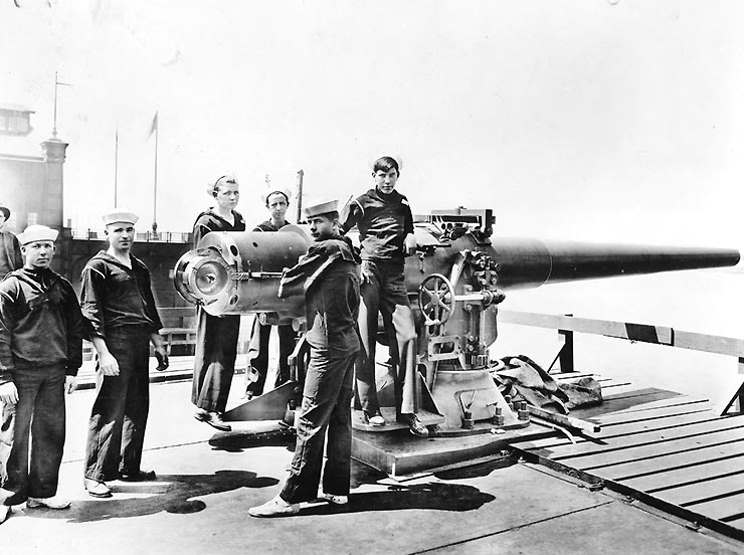|
A freak accident on the transport USS Mongolia ID-1615 on May 20, 1917 caused the U.S. Navy to redesign some of the ammunition used on their ships. Mongolia was a converted passenger ship being used as a troopship like so many of the ships of the time, and like many ships of the time the Mongolia was armed with defensive guns, in her case 6" guns fore and aft. On May 19, 1917 Mongolia departed New York with over 260 doctors, nurses and other medical staff of Red Cross Unit 12 bound for France and the carnage of the Great War, these were all volunteers who had been recruited mostly from Northwestern University and the University of Chicago. On a fine and clear day, Saturday May 20, 1917 when the ship was about 50 miles east of the Nantucket light vessel it was decided that the navy gunners would get in some practice, so the 6" guns were loaded and an audience of doctors and nurses came to watch, as most of them had never seen such guns fired before they were quite thrilled at the prospect of the show they were about to witness, of course it was more than a show as these guns and gunners would be responsible for protecting the ship in the event of a U-boat attack. The forward gun fired two rounds at a free floating target and then it was the stern gunners turn. They aimed the gun at the target and fired, seconds after the shot left the barrel two Red Cross nurses lay dead on the ship and a third was wounded. It was not immediately clear what had happened, but soon it was learned that brass from the mouth cup on the powder cartridge had ricocheted off a wave and hit the nurses. On was hit in the head and the other in the heart, both died instantly. The injured nurse, Miss Emma Matzen was treated and when the ship reached port was taken to the hospital where she recovered from her wounds. Services for the two nurses who had died were held at St. Stephen's Church in New York. This seemingly small episode caused a small firestorm when it was learned that some ammunition used on the merchant ships was defective. It was released that two other ships, St. Louis and her sister ship St. Paul, both troopers, had reported that shells from their 6" guns had exploded prematurely and some even in the barrel causing damage to the guns. St. Louis had to make one voyage from Europe without the benefit of her guns, both of which had been damaged by faulty shells and could not be replaced in England. The story was made worse when it was learned that the press knew all abut these explosions on the other ships, but did not report it because the Wilson administration had asked them to suppress the story due to national security. In the two cases sighted there were no deaths, but the deaths of two volunteer nurses, which some were saying was avoidable, caused the press to release some of the details of the previous events. The Navy and the government went into overdrive to find the cause and come up with a plausible story that the public would believe, like they always do. While there was a problem that was found, the cause of this tragedy was just one of those strange occurrences which may have never happened again even if nothing were done. The Senate held hearings, reports were written, tests were conducted and findings were made. It was learned that shells made before 1900 were indeed defective, or rather not up to the current standard of the day. The 6" shell was a two piece unit, the warhead and the powder charge, this was because the combined weight of both parts was too much for men to handle. Many of the shells had been produced during the Spanish-American War in 1898-99 and were of sufficient quality and durability to withstand the powder charge that was used at the time. But after the war the Navy changed to a smokeless powder which was more powerful and this is where the problem steamed from. There was also another problem, that was with the brass mouth cup, this was placed over the powder charge to keep it dry, a practice used by the Navy for 20 years. However because of the more powerful powder charge the brass cup was being forced into the shell in some cases cracking the shell causing it to detonate early, this was the case on the St. Louis and St. Paul, but not on the Mongolia. In the Mongolia case the brass cup was discharged from the gun and broke into several pieces, and as said before the pieces bounced off the sea and returned to the ship. Those who were killed and injured were over 150' forward and one deck above the gun. This was a tragic accident, and one that had not occurred before even though thousands of shells using the brass mouth cup had been fired in the previous two decades. The result was that the Navy had to recall hundreds if not thousands of shells and powder charges. Shells manufactured before 1900 were removed from service and all the powder charges either had to be disposed of or fitted with a paper or wood cover in place of the brass cup. |
© 2011 Michael W. Pocock MaritimeQuest.com |
 |
The 6" stern gun on USS Mongolia ID-1615. |
Roll of Honor |
 |
In memory of those who lost their lives in USS Mongolia ID-1615 "As long as we embrace them in our memory, their spirit will always be with us" |
Name |
Rate |
Notes |
|
Ayers, Edith |
Nurse |
Attica, Ohio |
|
Wood, Helen B. |
Nurse |
Evanston, Illinois |
2006 Daily Event |
||
2010 Daily Event |
||